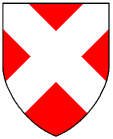
LIVES OF THE BISHOPS OF EXETER
GEORGE NEVYLL. - On the death of Bishop Lacy, John Halse Dean of Exeter had been nominated his successor at the special recommendation of King Henry VI.; but as he declined the proffered dignity, Pope Calixtus III. provided George Nevyll to the government of the vacant see. He was the youngest surviving son of Richard Nevyll Earl of Salisbury (beheaded at York, 38th Hen. VI.), by Alice his wife, sole daughter and heir of Thomas Montacute Earl of Salisbury, and brother of the celebrated King-maker, Richard Earl of Salisbury and Warwick; and received his education at Balliol College, Oxford, where, on taking the degree of Master of Arts in October, 1452, the sumptuous entertainment was given, recorded by Wood, its historian (lib. i. p. 219). The following year witnessed his election to this chancellorship of that university. He was barely in his twenty-fourth year when the temporalities of Exeter were restored to him on 21st March, 1456 (Rymer's 'Foedera,' vol. xi. p. 376). His Register of institutions commences with 10th April that year; for the primate Thomas Bourchier, his cousin, had already committed to him the spiritualities; but, notwithstanding his election, confirmation, and power of jurisdiction, by the special order of the Pope, his consecration was to be deferred until he should enter his twenty-seventh year; and it was eventually performed on 25th November 1458. In the meanwhile he had the precaution to commit the administration of the diocese to experienced theologians. In March, 1459, he was installed in his episcopal throne. His Register proves that he conferred holy orders in Crediton Church on 19th May, and in his own cathedral on 22nd September that year; that early in December he quitted the diocese for ever; and that on. 15th of that month he had arrived at Coventry on his route to London. King Henry VI., on 25th July, 1460, delivered to him the Great Seal, and it must be admitted that he disloyally employed the commanding influence of his station against his too confiding sovereign. For this treachery he may have considered himself recompensed by King Edward IV., who reappointed him to the chancellorship on 5th March, 1461, and translated him to the archbishopric of York in 1465. The lavish prodigality of his installation there on 19th January, 1466, may be seen in Godwin, &c. &c.
The course of restless ambition pursued by this timeserving prelate, his fondness for intrigue and entanglement in political strife, so foreign to his ecclesiastical profession, involved him in vexation, disgrace, and ruin; thus verifying the text, "Deceitful men shall not live out half their days." On 8th July, 1467, the Great Seal was abruptly taken from him; his revenues seized, his plate confiscated, his mitre converted into a crown, and his jewels divided between King Edward IV. and the Prince of Wales. Committed to close imprisonment, partly in England and partly at Guisnes, at the end of three years he was restored to liberty; but very shortly after, viz. on 8th June, 1476, aged 44, he died of a broken heart, "ex angore animi interiit" (Polydore Virgil's 'History,' p. 526).
Yet Lord Camphell offers this palliation for the unprincipled Chancellor (vol. i. p. 386, 'Lives,' &c.). "During the seven years he held the Great Seal I do not find any charge against him of partiality or corruption; and his sudden changes in politics, and the violence with which he; acted against his opponents, must be considered rather as characteristic of the age in which he lived, than bringing any great reproach upon his personal character"!
ARMS: - Gules, a Saltier argent. To this Westcote adds, "A pile of three, goboneted argent and azure; his mother's coat, Argent, three Lozenges in fess gules. Yet there is set for him, Gules, three Lozenges in fess argent, within a border or."
